Introduction
In the pursuit of a stronger, healthier body, few aspects are as crucial as core stability. Dumbbell oblique exercises stand out as a powerful method to fortify the muscles that flank the abdomen, contributing significantly to both daily functionality and athletic prowess. These movements not only sculpt a defined waistline but also enhance overall performance, making them essential for anyone dedicated to fitness.
As awareness of core strength grows, so does the recognition of the role these exercises play in injury prevention and improved athletic performance. With a variety of techniques and modifications available, integrating dumbbell oblique exercises into any workout routine becomes an accessible and impactful choice for enhancing well-being and resilience.
Embrace the opportunity to elevate fitness levels and foster a culture of health that benefits both individuals and teams alike.
Introduction to Dumbbell Oblique Exercises
Oblique exercises with dumbbells are powerful movements aimed at fortifying the oblique muscles situated on the sides of the abdomen. These muscles play a vital role in stability, which is essential for both daily activities and athletic performance. By incorporating dumbbells into these routines, individuals can enhance resistance, leading to more effective workouts that not only sculpt a defined waistline but also elevate overall athletic capabilities.
Enhancing the central muscles can alleviate specific kinds of back discomfort, as it supports the spine, rendering these activities especially advantageous. Recent trends indicate a growing popularity in core stability training, highlighting the increasing awareness of its importance among fitness enthusiasts and athletes. As noted by experts, engaging in regular physical activity helps older adults combat the fear of falling and the associated risks, according to the National Institute on Aging.
This highlights the significance of including activities like oblique exercises with dumbbells in fitness routines. Furthermore, Peloton instructors suggest various core-strengthening activities, such as:
- Bird dogs
- Bicycle crunches
These activities can enhance stability and strength. By promoting a culture of health and strength that benefits everyone, these activities play a vital role in comprehensive fitness strategies.
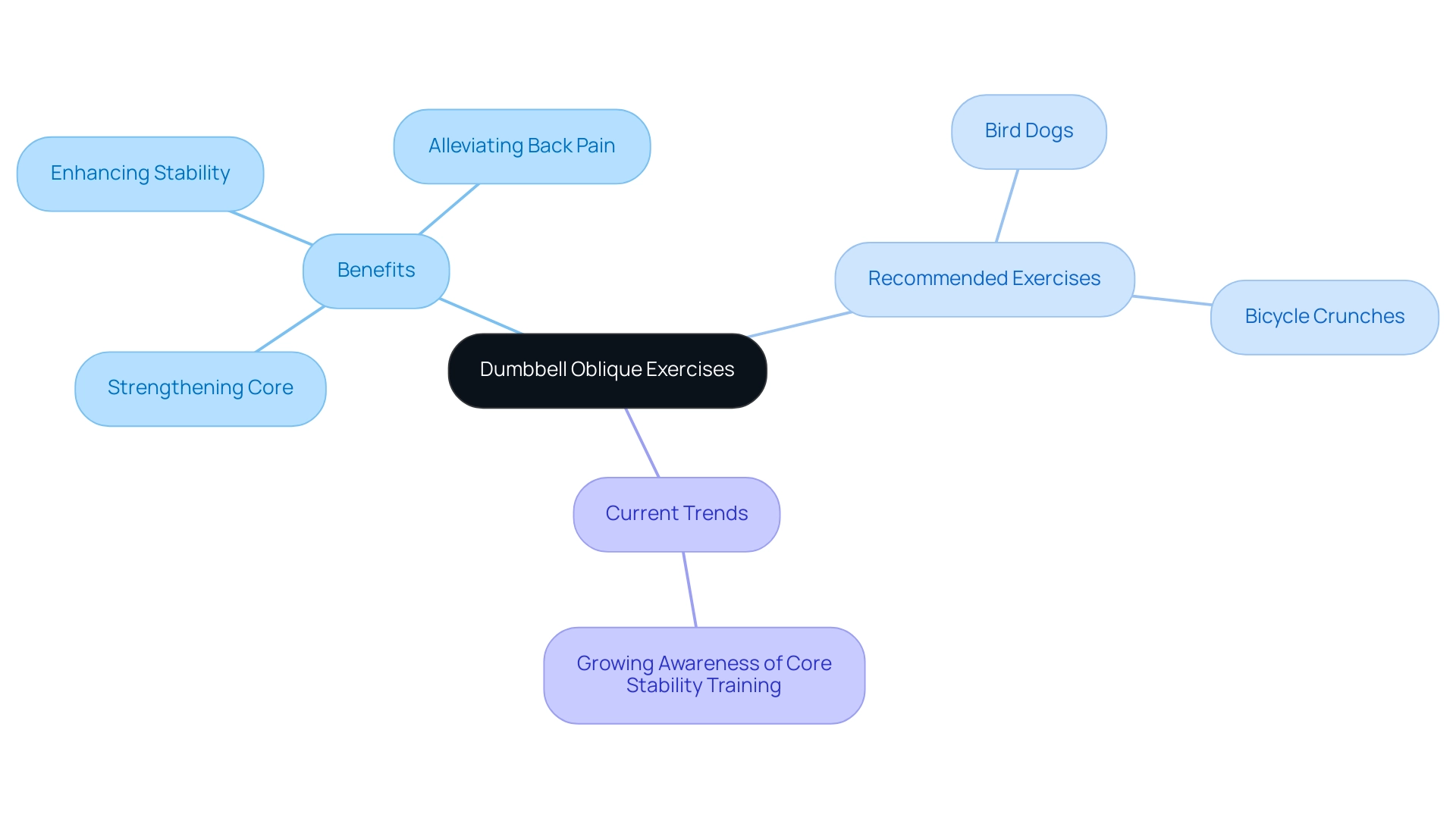
Exploring Different Dumbbell Oblique Exercises
Incorporating oblique exercises with dumbbells into your fitness plan can provide substantial advantages for overall strength and wellness. Here are some of the most effective exercises to consider:
-
Weight Side Bend: Stand tall with your feet shoulder-width apart, grasping a weight in one hand.
Lean to the side, allowing the weight to glide down toward your knee, then return to the upright position. This exercise effectively targets the side muscles through oblique exercises with dumbbells while enhancing core stability.
-
Dumbbell Russian Twist: Sit on the floor with your knees bent and your feet flat.
Hold a weight with both hands, lean back slightly, and twist your torso to one side, then to the other. This dynamic movement engages the obliques and promotes rotational strength by incorporating oblique exercises with dumbbells.
-
Windmill with Weights: Position your feet wider than shoulder-width, with a weight held overhead.
Rotate your torso, lowering the weight towards your opposite foot while maintaining a straight arm. This exercise, including oblique exercises with dumbbells, challenges core stability and flexibility, making it a powerful addition to any routine.
-
Weighted Plank with Rotation: Get into a plank position, holding a weight in one hand.
Rotate your torso, lifting the dumbbell toward the ceiling before returning to the plank position. This move incorporates oblique exercises with dumbbells, engaging the obliques and strengthening the entire core. These activities can be easily adjusted to accommodate different fitness levels, making them suitable for everyone.
As statistics reveal, 40% of men recover within 48 hours after finishing activities to failure, highlighting the importance of recovery after performing these movements. Frost highlights that raising weights during workouts 'shreds your legs into powerful pins by targeting your fast-twitch lower-body muscles,' which emphasizes their effectiveness. Furthermore, the case study named '33 Best Weights Activities For Chest, Arms, Shoulders, Back & Legs' offers a thorough guide to the top weight training routines, outlining their effectiveness across different muscle groups.
By embracing these dynamic movements, you can cultivate a culture of health and resilience within your team, fostering both physical and mental well-being.
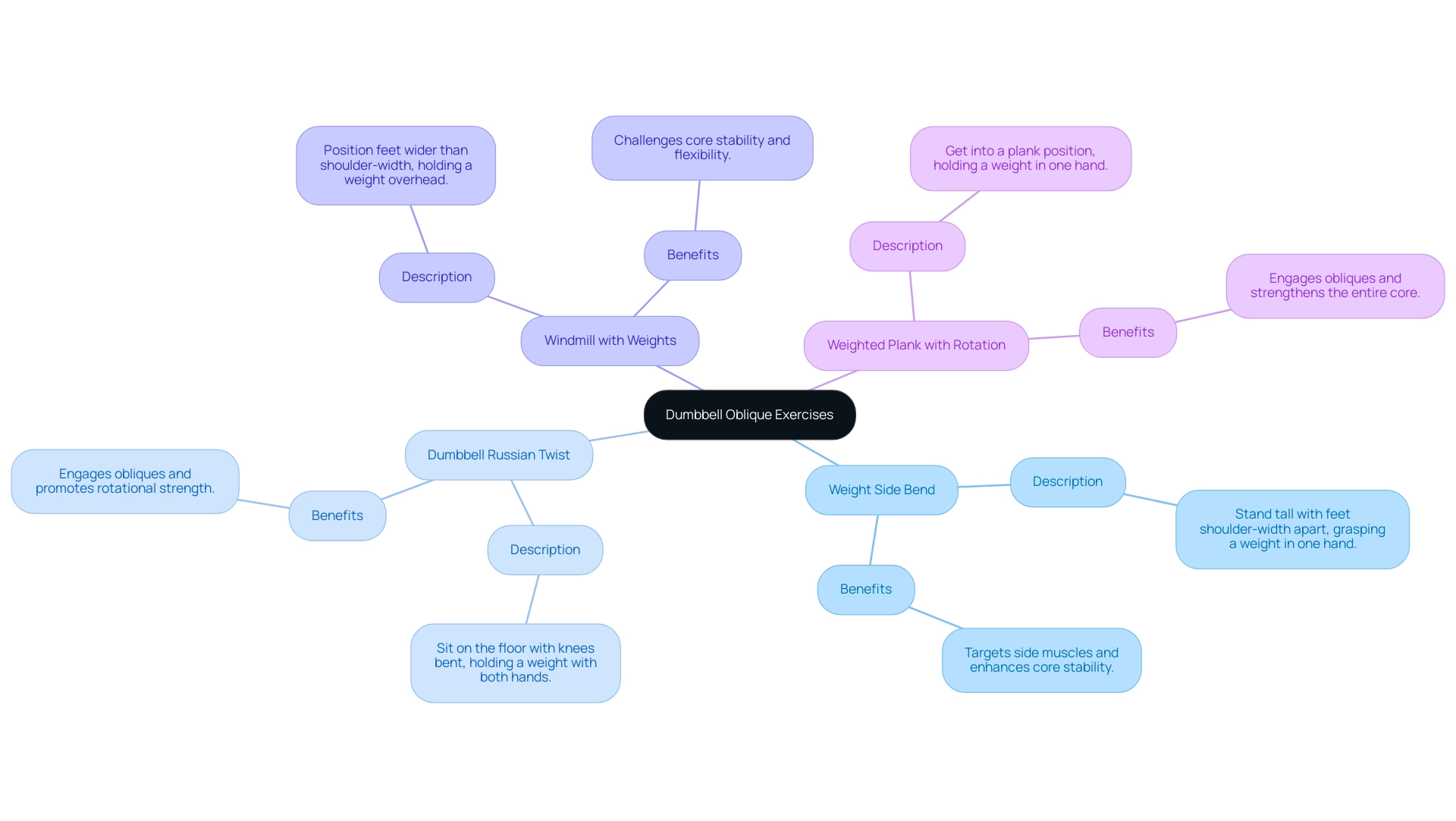
Benefits of Incorporating Dumbbell Oblique Exercises
Incorporating dumbbell lateral movements into your fitness routine can provide numerous advantages that go well beyond appearance. Here’s why prioritizing these exercises is essential:
- Enhanced Abdominal Strength: Targeting the oblique muscles, these exercises significantly bolster abdominal strength, which is vital for maintaining stability and proper posture. As emphasized in a systematic review, effective training of the central muscles not only improves muscle endurance but also enhances balance, creating a solid foundation for all physical activities. Erika Zemková observed in her research that strengthening the center of the body plays a vital role in enhancing muscle strength, endurance, and flexibility, which is essential for athletes.
- Injury Prevention: A robust center is your body’s natural armor, providing crucial support for the spine and minimizing the risk of muscle strains during various activities. Significantly, strength training has been demonstrated to reduce nursing home admissions by an impressive 84% in older individuals after hip fracture surgery, illustrating the profound influence of fundamental strength on injury resilience. This statistic highlights the significance of including fundamental workouts for overall wellness and injury avoidance.
- Enhanced Athletic Performance: For athletes, especially in sports that necessitate rotational movements—such as baseball, tennis, and golf—strong obliques can be achieved through oblique exercises with dumbbells. Research has demonstrated that targeted training of the midsection leads to enhancements in physical strength and balance, directly contributing to better performance on the field. A systematic literature review and meta-analysis indicated that fundamental training significantly improved physical strength (fundamental endurance and balance) but had a smaller effect on sport-specific performance, suggesting a need for well-designed foundational training programs.
- Aesthetic Benefits: Engaging in these activities can lead to a more sculpted appearance around the waist, a motivating factor for many individuals committed to their fitness goals. A toned core not only enhances self-assurance but also promotes a regular exercise regimen.
- Improved Functional Fitness: Fortifying your side muscles can enhance your capacity to execute daily activities with greater ease. This functional fitness aspect makes daily tasks more effective, enabling you to move through your day with increased energy and flexibility.
Incorporating oblique exercises with dumbbells into your routine not only strengthens your body against injuries but also enhances your overall quality of life—a compelling reason to embrace this essential fitness component.
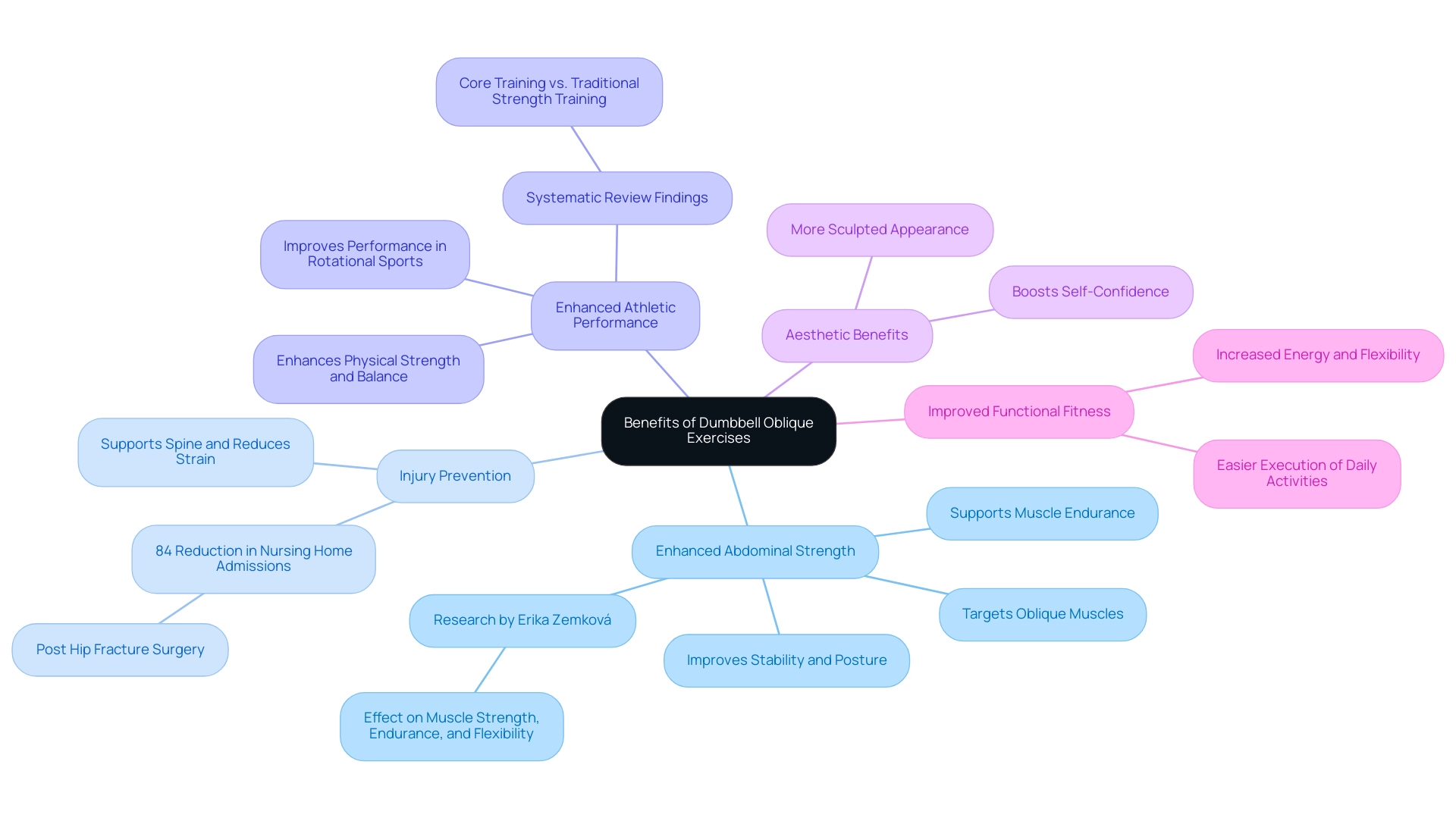
Techniques for Effective Dumbbell Oblique Exercises
To maximize the effectiveness of dumbbell oblique exercises and ensure safety, consider the following essential techniques:
- Maintain Proper Posture: Stand or sit up straight, keeping your spine aligned to prevent strain. Good posture is foundational for any effective workout, significantly impacting your performance and safety.
- Engage Your Core: Always activate your core muscles throughout your workouts. This not only provides stability but also enhances your overall strength and performance during your workouts.
- Control Your Movements: Perform each activity in a slow and controlled manner. This approach not only maximizes muscle engagement but also significantly reduces the risk of injury, empowering you to push your limits safely.
- Breathe Properly: Focus on your breathing—inhale during the preparation phase and exhale during the exertion phase. This practice maintains proper oxygen flow, which is crucial for optimal performance and endurance.
- Start with Light Weights: If you are new to these activities, begin with lighter weights. Mastering the technique with manageable weights will lay a strong foundation for progressing to heavier ones.
Nick Rizzo, Fitness Research Director, emphasizes that "the best strength training program for beginners is Stronglifts 5x5 Workout," which aligns with the principles of building a strong foundation through proper techniques. Additionally, Nicholas Rizzo's personal records place him in the top 6% of deadlifts with 515 lbs, showcasing the effectiveness of strength training when executed correctly. According to a case study analyzing the comparative effects of resistance training, significant differences were observed in muscle strength and hypertrophy outcomes among various training conditions.
By integrating oblique exercises with dumbbells into your workouts, you can transform them into powerful sessions that not only build strength but also promote safety and well-being. Remember, effective training is about more than just lifting weights; it's about lifting yourself and your team towards a healthier future.
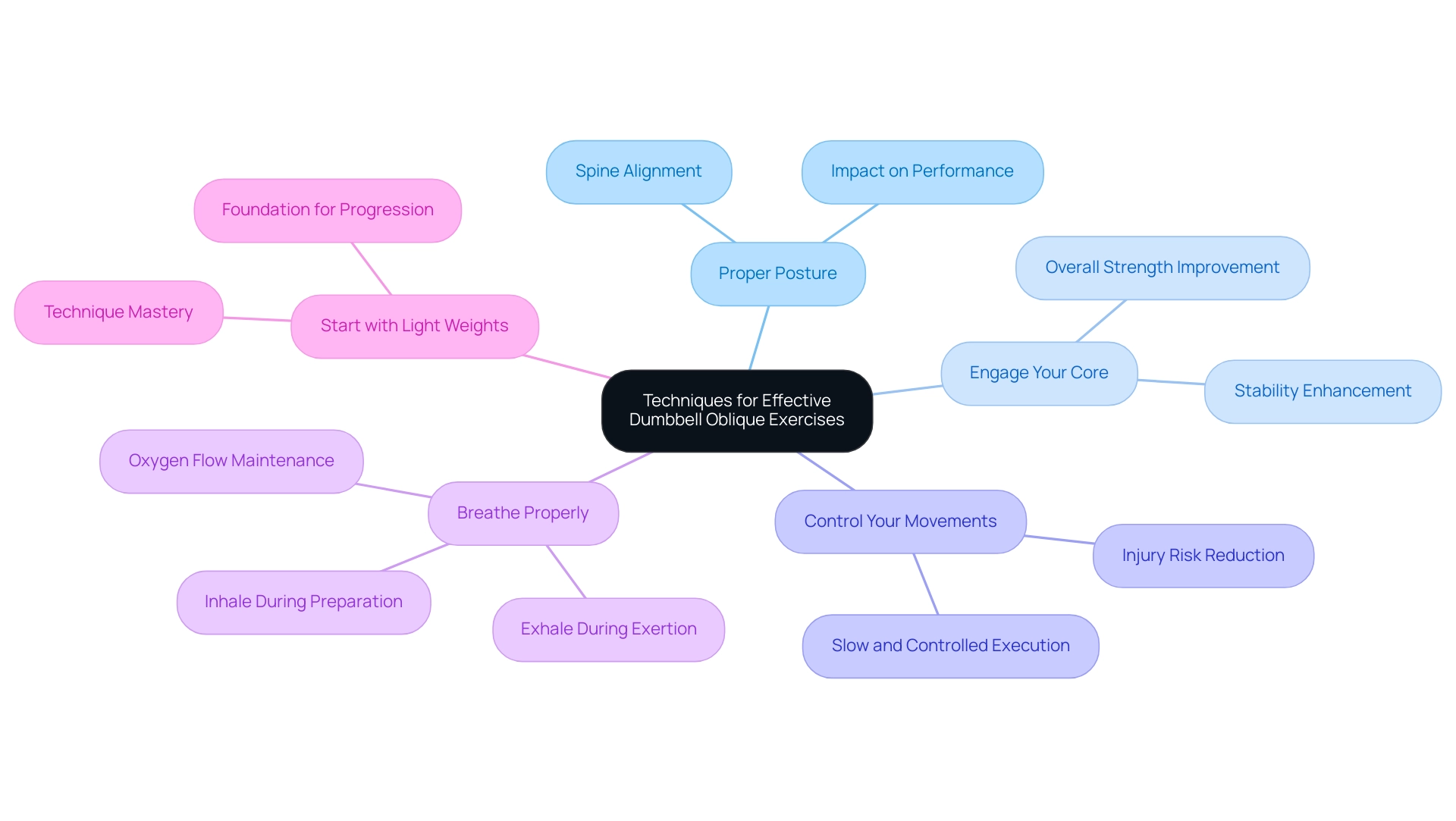
Integrating Dumbbell Oblique Exercises into Your Workout Routine
To effortlessly include weightlifting side movements in your workout regimen, think about applying these motivating strategies:
- Create a Balanced Routine: Emphasize a holistic approach by combining cardio, strength training, and flexibility activities, ensuring your fitness program covers all facets of physical health. Consistent physical activity has been demonstrated to enhance bone density, as highlighted by research suggesting that training is beneficial for improving bone health in older women with low bone mineral density.
- Schedule Specific Days: Allocate specific days for central workouts, incorporating weight-based lateral movements with other stability-enhancing activities to establish a targeted training plan.
- Use Supersets: Optimize workout efficiency by pairing lateral movements with other strength-building tasks. For instance, combine a dumbbell side bend with a dumbbell squat to challenge multiple muscle groups simultaneously, and incorporate oblique exercises with dumbbells into your warm-ups by starting your sessions with lighter weights. This not only activates your core muscles but also prepares your body for more intense training.
- Track Your Progress: Maintain a workout log to monitor your improvements in strength and endurance over time. Tracking progress can serve as a powerful motivator, pushing you to stay committed to your fitness journey.
By embracing these strategies, you can effectively enhance your overall health and performance, reinforcing the critical role of balanced fitness routines in achieving wellness goals. Moreover, it's important to note that meeting the minimum for moderate and vigorous activity can reduce cardiovascular disease mortality by 22% to 31%. As one expert noted, there is no harmful effect of high, long-term vigorous physical activity on cardiovascular health, which underscores the importance of a well-rounded fitness program.
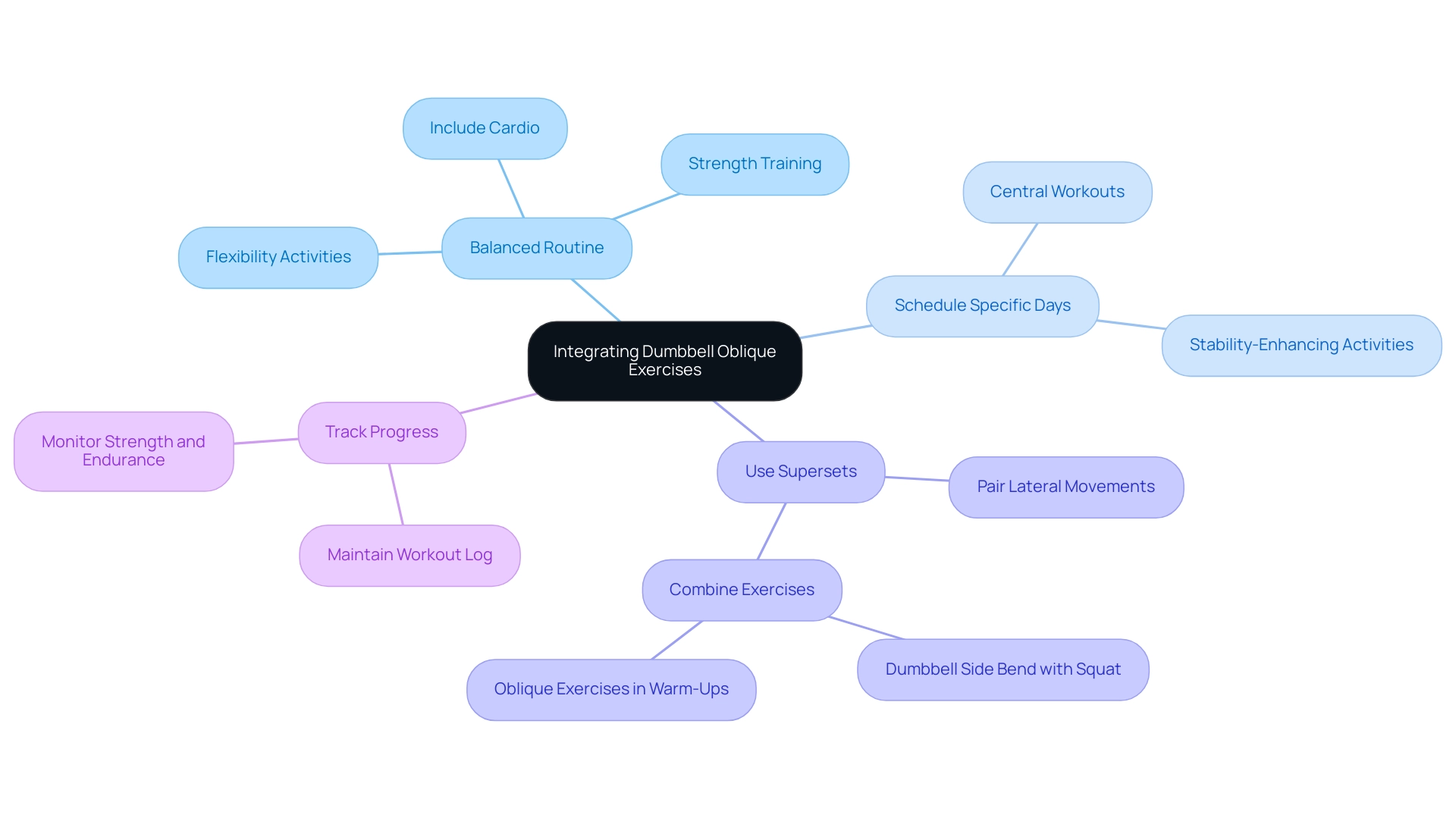
Conclusion
Integrating dumbbell oblique exercises into a fitness routine offers a myriad of benefits that extend well beyond aesthetic improvements. By targeting the oblique muscles, these exercises enhance core strength, which is vital for stability, posture, and overall physical performance. They serve as a crucial line of defense against injuries by supporting the spine and reducing the risk of muscle strains, especially in older adults. Furthermore, strong obliques are essential for athletes involved in sports requiring rotational movements, leading to improved performance and agility.
Incorporating these exercises is not only about building strength but also about fostering a culture of health and resilience. They can easily fit into any workout regimen, whether through:
- Dedicated core days
- Supersets
- Even as part of warm-up routines
Maintaining proper techniques ensures that workouts are safe and effective, allowing individuals to push their limits confidently.
Ultimately, embracing dumbbell oblique exercises is a powerful step towards enhancing overall well-being. By committing to these movements, individuals not only cultivate a stronger core but also improve their functional fitness, making daily activities easier and more efficient. Now is the time to prioritize core stability and elevate fitness levels, reaping the rewards of a robust and resilient body.




